Case Study: Intellectual Property Rights and the Change UK Trademark
VerifiedAdded on 2022/12/09
|7
|1457
|486
Case Study
AI Summary
This case study analyzes the intellectual property rights dispute between Change.org and the political party Change UK. The assignment examines whether Change UK infringed on Change.org's trademark under Common Law and the Trademarks Act 1985. It explores key legal concepts like copyright, trademark registration, and infringement by confusion, considering factors such as the relatedness of goods/services, similarity of marks, appearance/sound, and intention. The analysis references relevant case law, including Google vs. Equustek Solutions, Louis Vuitton vs. Louis Vuiton Dak, and Choose Energy Inc. vs. American Petroleum Institute, to determine the likelihood of confusion and the potential for trademark infringement. The conclusion determines that Change UK did infringe upon the trademark held by Change.org.
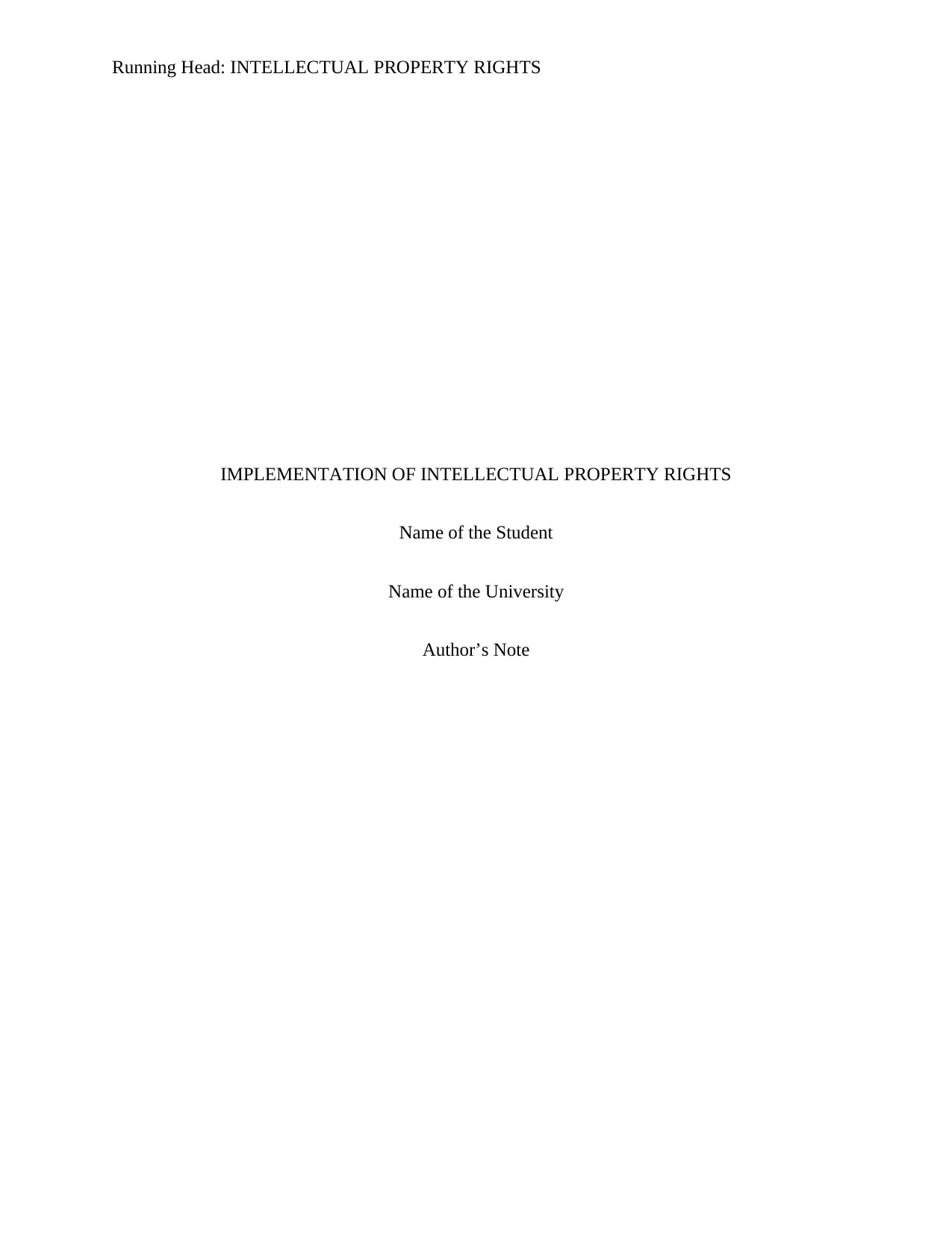
Running Head: INTELLECTUAL PROPERTY RIGHTS
IMPLEMENTATION OF INTELLECTUAL PROPERTY RIGHTS
Name of the Student
Name of the University
Author’s Note
IMPLEMENTATION OF INTELLECTUAL PROPERTY RIGHTS
Name of the Student
Name of the University
Author’s Note
Paraphrase This Document
Need a fresh take? Get an instant paraphrase of this document with our AI Paraphraser
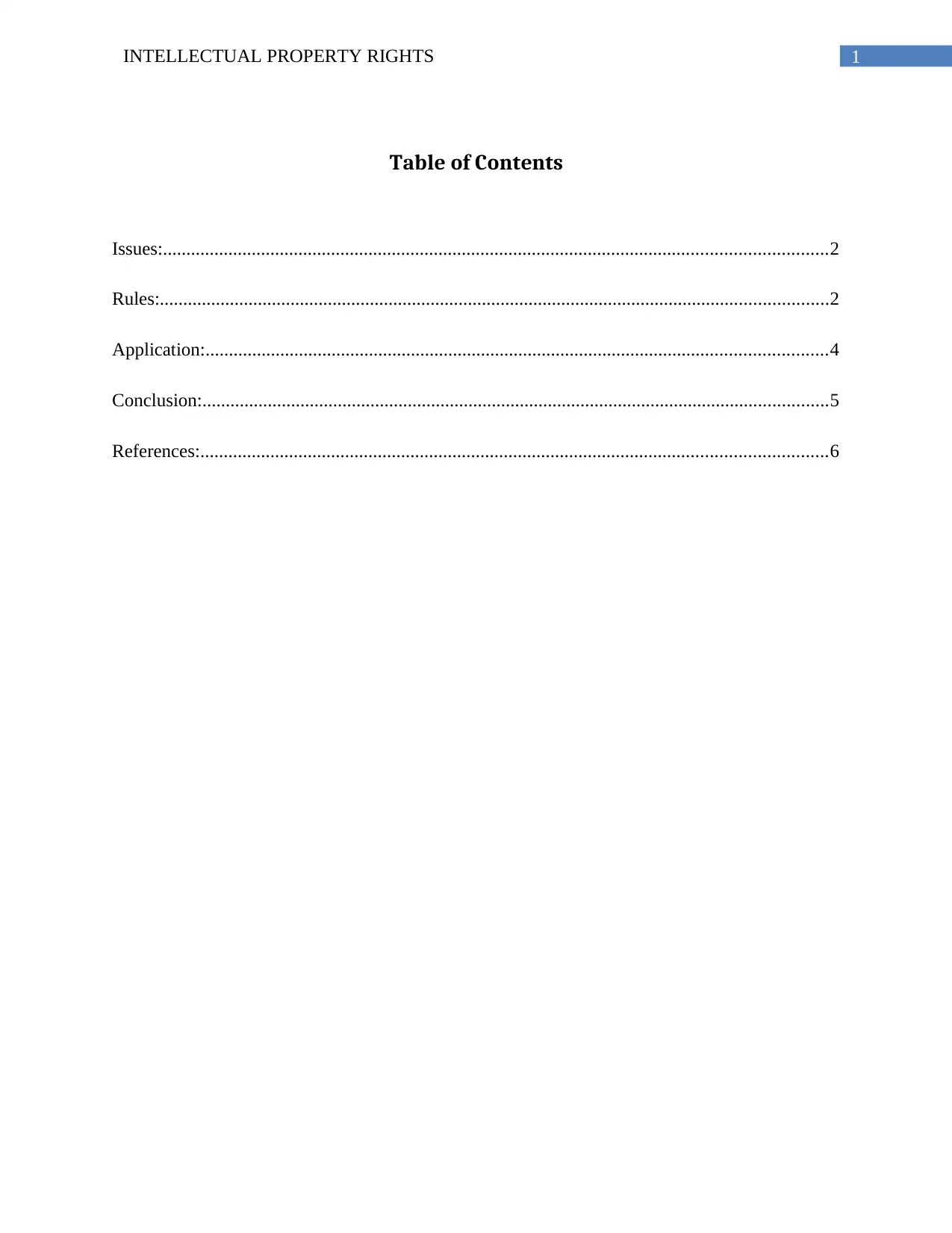
1INTELLECTUAL PROPERTY RIGHTS
Table of Contents
Issues:..............................................................................................................................................2
Rules:...............................................................................................................................................2
Application:.....................................................................................................................................4
Conclusion:......................................................................................................................................5
References:......................................................................................................................................6
Table of Contents
Issues:..............................................................................................................................................2
Rules:...............................................................................................................................................2
Application:.....................................................................................................................................4
Conclusion:......................................................................................................................................5
References:......................................................................................................................................6
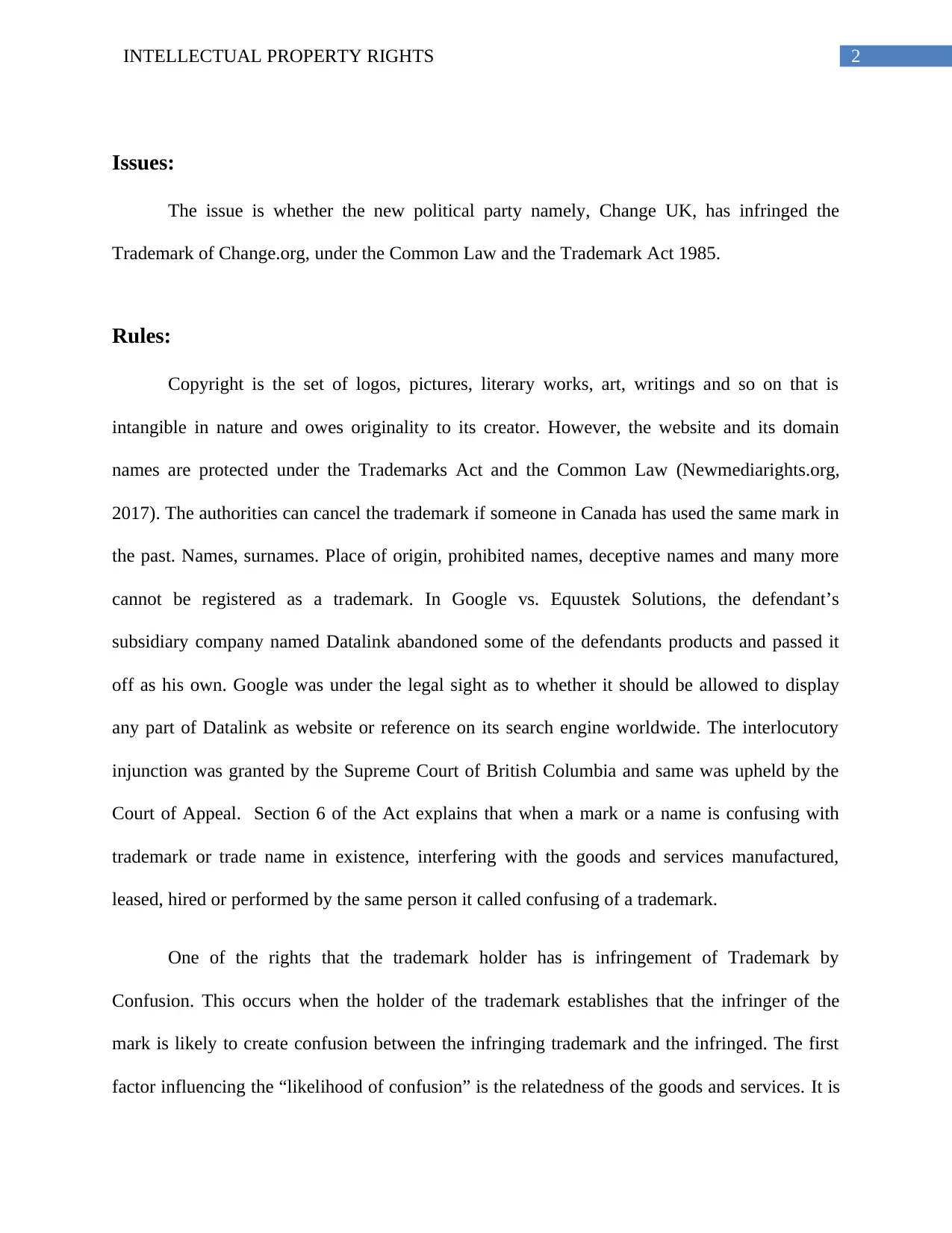
2INTELLECTUAL PROPERTY RIGHTS
Issues:
The issue is whether the new political party namely, Change UK, has infringed the
Trademark of Change.org, under the Common Law and the Trademark Act 1985.
Rules:
Copyright is the set of logos, pictures, literary works, art, writings and so on that is
intangible in nature and owes originality to its creator. However, the website and its domain
names are protected under the Trademarks Act and the Common Law (Newmediarights.org,
2017). The authorities can cancel the trademark if someone in Canada has used the same mark in
the past. Names, surnames. Place of origin, prohibited names, deceptive names and many more
cannot be registered as a trademark. In Google vs. Equustek Solutions, the defendant’s
subsidiary company named Datalink abandoned some of the defendants products and passed it
off as his own. Google was under the legal sight as to whether it should be allowed to display
any part of Datalink as website or reference on its search engine worldwide. The interlocutory
injunction was granted by the Supreme Court of British Columbia and same was upheld by the
Court of Appeal. Section 6 of the Act explains that when a mark or a name is confusing with
trademark or trade name in existence, interfering with the goods and services manufactured,
leased, hired or performed by the same person it called confusing of a trademark.
One of the rights that the trademark holder has is infringement of Trademark by
Confusion. This occurs when the holder of the trademark establishes that the infringer of the
mark is likely to create confusion between the infringing trademark and the infringed. The first
factor influencing the “likelihood of confusion” is the relatedness of the goods and services. It is
Issues:
The issue is whether the new political party namely, Change UK, has infringed the
Trademark of Change.org, under the Common Law and the Trademark Act 1985.
Rules:
Copyright is the set of logos, pictures, literary works, art, writings and so on that is
intangible in nature and owes originality to its creator. However, the website and its domain
names are protected under the Trademarks Act and the Common Law (Newmediarights.org,
2017). The authorities can cancel the trademark if someone in Canada has used the same mark in
the past. Names, surnames. Place of origin, prohibited names, deceptive names and many more
cannot be registered as a trademark. In Google vs. Equustek Solutions, the defendant’s
subsidiary company named Datalink abandoned some of the defendants products and passed it
off as his own. Google was under the legal sight as to whether it should be allowed to display
any part of Datalink as website or reference on its search engine worldwide. The interlocutory
injunction was granted by the Supreme Court of British Columbia and same was upheld by the
Court of Appeal. Section 6 of the Act explains that when a mark or a name is confusing with
trademark or trade name in existence, interfering with the goods and services manufactured,
leased, hired or performed by the same person it called confusing of a trademark.
One of the rights that the trademark holder has is infringement of Trademark by
Confusion. This occurs when the holder of the trademark establishes that the infringer of the
mark is likely to create confusion between the infringing trademark and the infringed. The first
factor influencing the “likelihood of confusion” is the relatedness of the goods and services. It is
⊘ This is a preview!⊘
Do you want full access?
Subscribe today to unlock all pages.

Trusted by 1+ million students worldwide
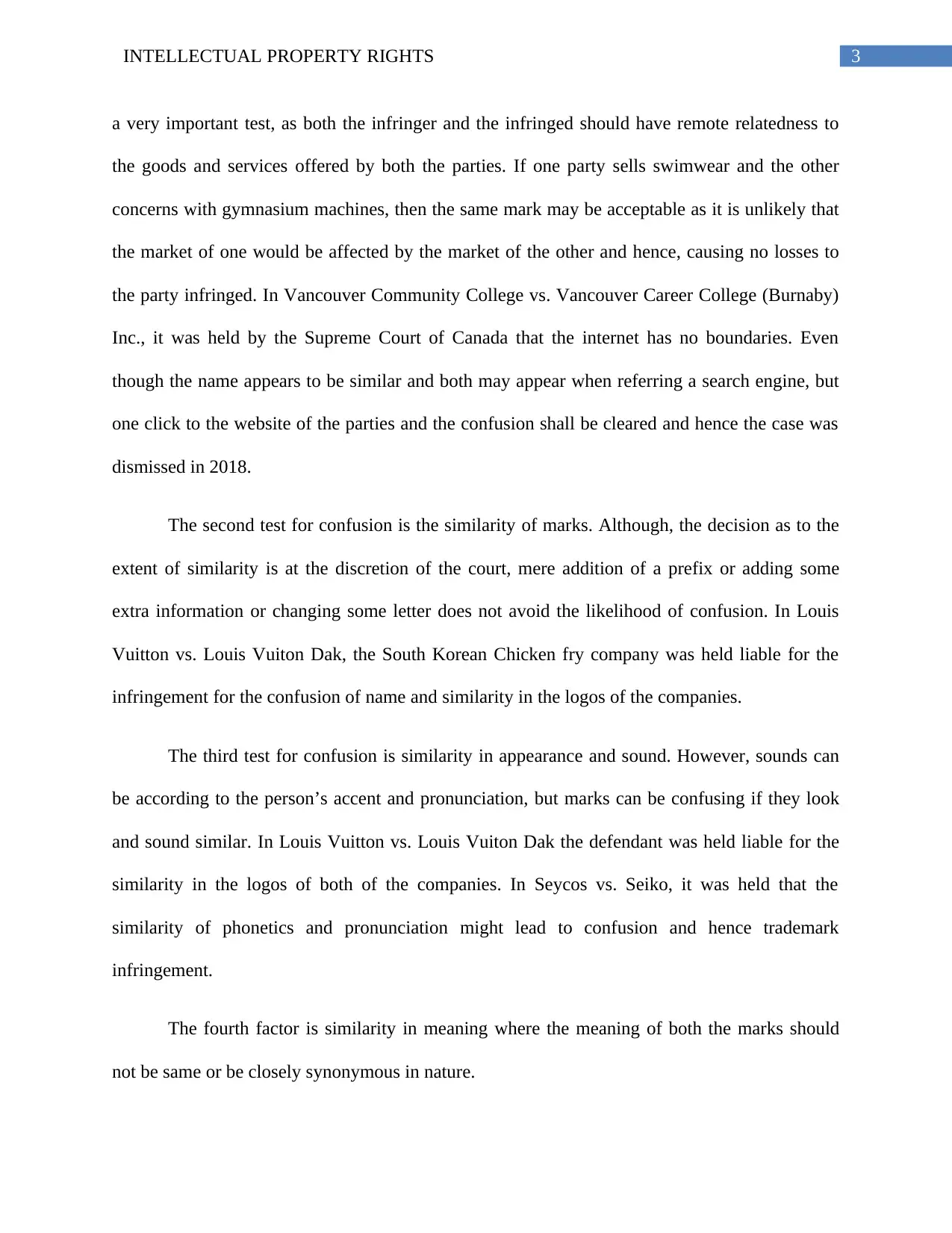
3INTELLECTUAL PROPERTY RIGHTS
a very important test, as both the infringer and the infringed should have remote relatedness to
the goods and services offered by both the parties. If one party sells swimwear and the other
concerns with gymnasium machines, then the same mark may be acceptable as it is unlikely that
the market of one would be affected by the market of the other and hence, causing no losses to
the party infringed. In Vancouver Community College vs. Vancouver Career College (Burnaby)
Inc., it was held by the Supreme Court of Canada that the internet has no boundaries. Even
though the name appears to be similar and both may appear when referring a search engine, but
one click to the website of the parties and the confusion shall be cleared and hence the case was
dismissed in 2018.
The second test for confusion is the similarity of marks. Although, the decision as to the
extent of similarity is at the discretion of the court, mere addition of a prefix or adding some
extra information or changing some letter does not avoid the likelihood of confusion. In Louis
Vuitton vs. Louis Vuiton Dak, the South Korean Chicken fry company was held liable for the
infringement for the confusion of name and similarity in the logos of the companies.
The third test for confusion is similarity in appearance and sound. However, sounds can
be according to the person’s accent and pronunciation, but marks can be confusing if they look
and sound similar. In Louis Vuitton vs. Louis Vuiton Dak the defendant was held liable for the
similarity in the logos of both of the companies. In Seycos vs. Seiko, it was held that the
similarity of phonetics and pronunciation might lead to confusion and hence trademark
infringement.
The fourth factor is similarity in meaning where the meaning of both the marks should
not be same or be closely synonymous in nature.
a very important test, as both the infringer and the infringed should have remote relatedness to
the goods and services offered by both the parties. If one party sells swimwear and the other
concerns with gymnasium machines, then the same mark may be acceptable as it is unlikely that
the market of one would be affected by the market of the other and hence, causing no losses to
the party infringed. In Vancouver Community College vs. Vancouver Career College (Burnaby)
Inc., it was held by the Supreme Court of Canada that the internet has no boundaries. Even
though the name appears to be similar and both may appear when referring a search engine, but
one click to the website of the parties and the confusion shall be cleared and hence the case was
dismissed in 2018.
The second test for confusion is the similarity of marks. Although, the decision as to the
extent of similarity is at the discretion of the court, mere addition of a prefix or adding some
extra information or changing some letter does not avoid the likelihood of confusion. In Louis
Vuitton vs. Louis Vuiton Dak, the South Korean Chicken fry company was held liable for the
infringement for the confusion of name and similarity in the logos of the companies.
The third test for confusion is similarity in appearance and sound. However, sounds can
be according to the person’s accent and pronunciation, but marks can be confusing if they look
and sound similar. In Louis Vuitton vs. Louis Vuiton Dak the defendant was held liable for the
similarity in the logos of both of the companies. In Seycos vs. Seiko, it was held that the
similarity of phonetics and pronunciation might lead to confusion and hence trademark
infringement.
The fourth factor is similarity in meaning where the meaning of both the marks should
not be same or be closely synonymous in nature.
Paraphrase This Document
Need a fresh take? Get an instant paraphrase of this document with our AI Paraphraser
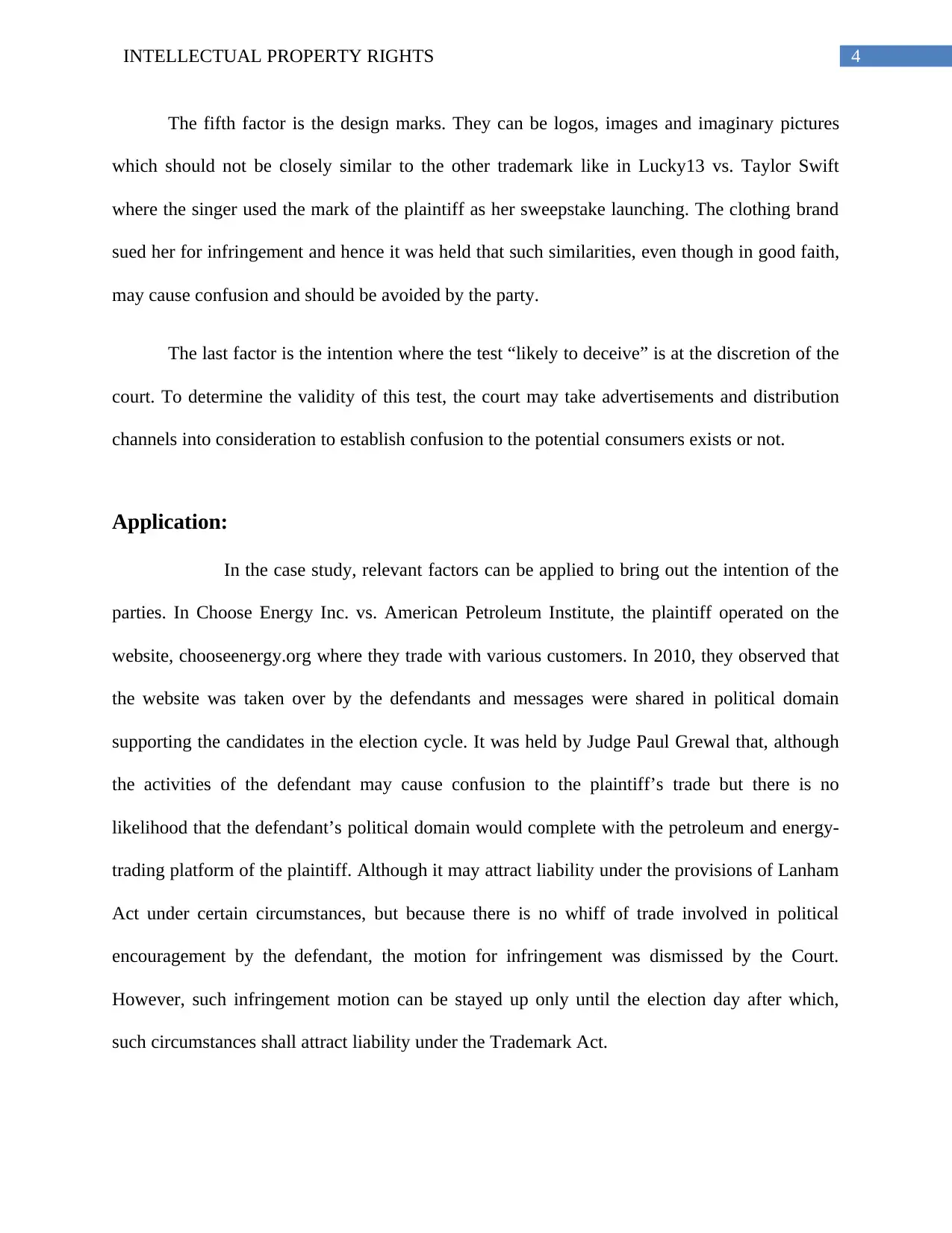
4INTELLECTUAL PROPERTY RIGHTS
The fifth factor is the design marks. They can be logos, images and imaginary pictures
which should not be closely similar to the other trademark like in Lucky13 vs. Taylor Swift
where the singer used the mark of the plaintiff as her sweepstake launching. The clothing brand
sued her for infringement and hence it was held that such similarities, even though in good faith,
may cause confusion and should be avoided by the party.
The last factor is the intention where the test “likely to deceive” is at the discretion of the
court. To determine the validity of this test, the court may take advertisements and distribution
channels into consideration to establish confusion to the potential consumers exists or not.
Application:
In the case study, relevant factors can be applied to bring out the intention of the
parties. In Choose Energy Inc. vs. American Petroleum Institute, the plaintiff operated on the
website, chooseenergy.org where they trade with various customers. In 2010, they observed that
the website was taken over by the defendants and messages were shared in political domain
supporting the candidates in the election cycle. It was held by Judge Paul Grewal that, although
the activities of the defendant may cause confusion to the plaintiff’s trade but there is no
likelihood that the defendant’s political domain would complete with the petroleum and energy-
trading platform of the plaintiff. Although it may attract liability under the provisions of Lanham
Act under certain circumstances, but because there is no whiff of trade involved in political
encouragement by the defendant, the motion for infringement was dismissed by the Court.
However, such infringement motion can be stayed up only until the election day after which,
such circumstances shall attract liability under the Trademark Act.
The fifth factor is the design marks. They can be logos, images and imaginary pictures
which should not be closely similar to the other trademark like in Lucky13 vs. Taylor Swift
where the singer used the mark of the plaintiff as her sweepstake launching. The clothing brand
sued her for infringement and hence it was held that such similarities, even though in good faith,
may cause confusion and should be avoided by the party.
The last factor is the intention where the test “likely to deceive” is at the discretion of the
court. To determine the validity of this test, the court may take advertisements and distribution
channels into consideration to establish confusion to the potential consumers exists or not.
Application:
In the case study, relevant factors can be applied to bring out the intention of the
parties. In Choose Energy Inc. vs. American Petroleum Institute, the plaintiff operated on the
website, chooseenergy.org where they trade with various customers. In 2010, they observed that
the website was taken over by the defendants and messages were shared in political domain
supporting the candidates in the election cycle. It was held by Judge Paul Grewal that, although
the activities of the defendant may cause confusion to the plaintiff’s trade but there is no
likelihood that the defendant’s political domain would complete with the petroleum and energy-
trading platform of the plaintiff. Although it may attract liability under the provisions of Lanham
Act under certain circumstances, but because there is no whiff of trade involved in political
encouragement by the defendant, the motion for infringement was dismissed by the Court.
However, such infringement motion can be stayed up only until the election day after which,
such circumstances shall attract liability under the Trademark Act.
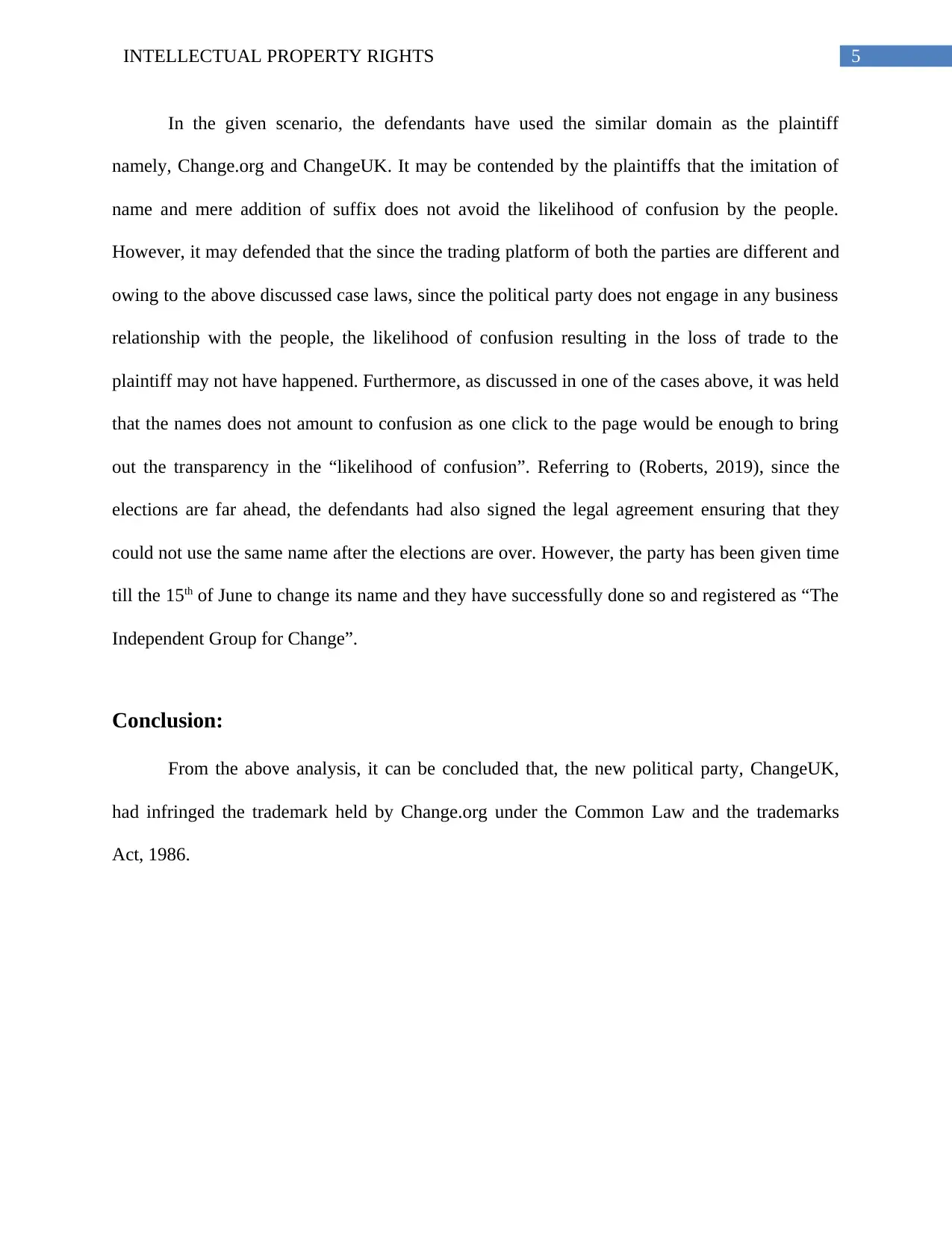
5INTELLECTUAL PROPERTY RIGHTS
In the given scenario, the defendants have used the similar domain as the plaintiff
namely, Change.org and ChangeUK. It may be contended by the plaintiffs that the imitation of
name and mere addition of suffix does not avoid the likelihood of confusion by the people.
However, it may defended that the since the trading platform of both the parties are different and
owing to the above discussed case laws, since the political party does not engage in any business
relationship with the people, the likelihood of confusion resulting in the loss of trade to the
plaintiff may not have happened. Furthermore, as discussed in one of the cases above, it was held
that the names does not amount to confusion as one click to the page would be enough to bring
out the transparency in the “likelihood of confusion”. Referring to (Roberts, 2019), since the
elections are far ahead, the defendants had also signed the legal agreement ensuring that they
could not use the same name after the elections are over. However, the party has been given time
till the 15th of June to change its name and they have successfully done so and registered as “The
Independent Group for Change”.
Conclusion:
From the above analysis, it can be concluded that, the new political party, ChangeUK,
had infringed the trademark held by Change.org under the Common Law and the trademarks
Act, 1986.
In the given scenario, the defendants have used the similar domain as the plaintiff
namely, Change.org and ChangeUK. It may be contended by the plaintiffs that the imitation of
name and mere addition of suffix does not avoid the likelihood of confusion by the people.
However, it may defended that the since the trading platform of both the parties are different and
owing to the above discussed case laws, since the political party does not engage in any business
relationship with the people, the likelihood of confusion resulting in the loss of trade to the
plaintiff may not have happened. Furthermore, as discussed in one of the cases above, it was held
that the names does not amount to confusion as one click to the page would be enough to bring
out the transparency in the “likelihood of confusion”. Referring to (Roberts, 2019), since the
elections are far ahead, the defendants had also signed the legal agreement ensuring that they
could not use the same name after the elections are over. However, the party has been given time
till the 15th of June to change its name and they have successfully done so and registered as “The
Independent Group for Change”.
Conclusion:
From the above analysis, it can be concluded that, the new political party, ChangeUK,
had infringed the trademark held by Change.org under the Common Law and the trademarks
Act, 1986.
⊘ This is a preview!⊘
Do you want full access?
Subscribe today to unlock all pages.

Trusted by 1+ million students worldwide
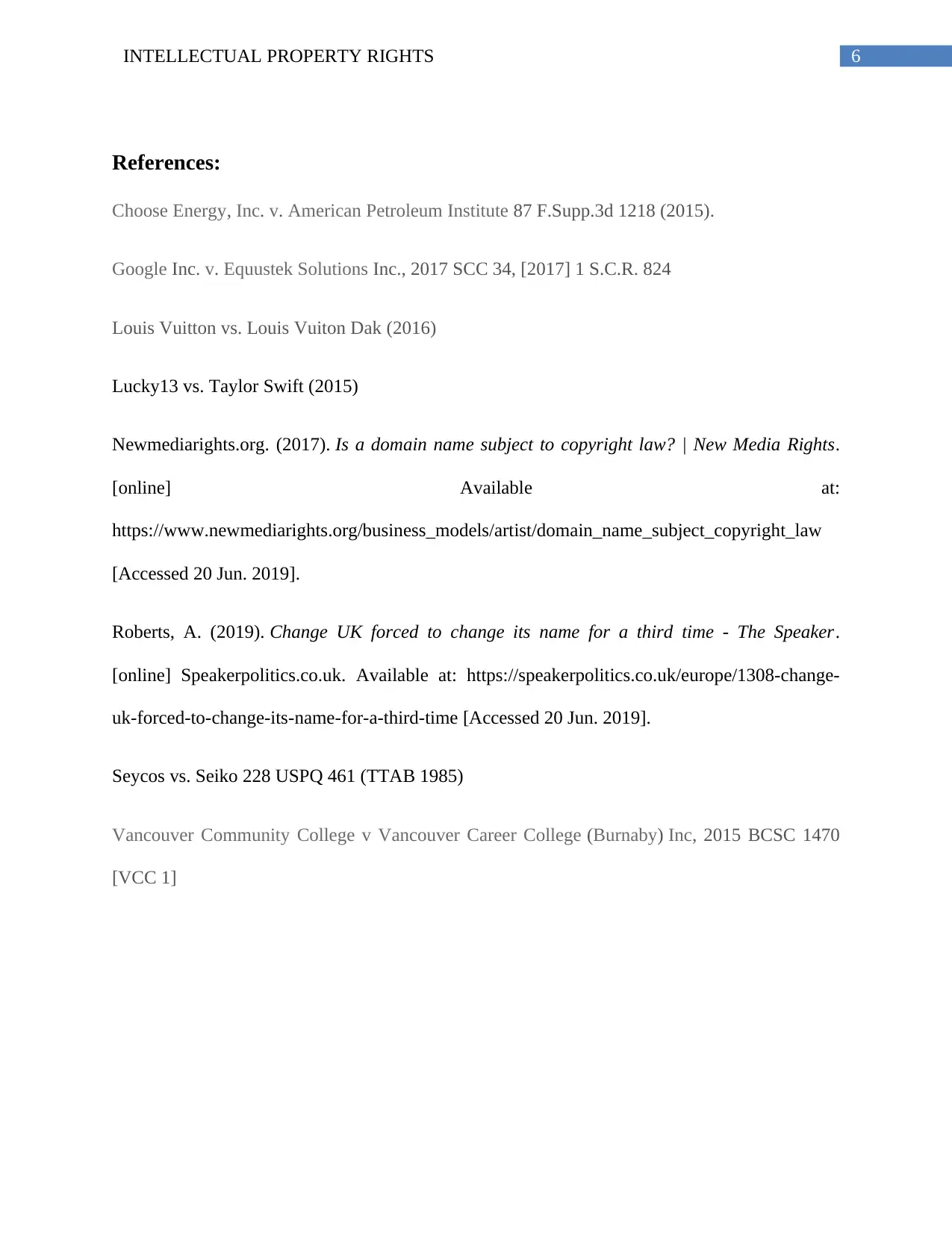
6INTELLECTUAL PROPERTY RIGHTS
References:
Choose Energy, Inc. v. American Petroleum Institute 87 F.Supp.3d 1218 (2015).
Google Inc. v. Equustek Solutions Inc., 2017 SCC 34, [2017] 1 S.C.R. 824
Louis Vuitton vs. Louis Vuiton Dak (2016)
Lucky13 vs. Taylor Swift (2015)
Newmediarights.org. (2017). Is a domain name subject to copyright law? | New Media Rights.
[online] Available at:
https://www.newmediarights.org/business_models/artist/domain_name_subject_copyright_law
[Accessed 20 Jun. 2019].
Roberts, A. (2019). Change UK forced to change its name for a third time - The Speaker.
[online] Speakerpolitics.co.uk. Available at: https://speakerpolitics.co.uk/europe/1308-change-
uk-forced-to-change-its-name-for-a-third-time [Accessed 20 Jun. 2019].
Seycos vs. Seiko 228 USPQ 461 (TTAB 1985)
Vancouver Community College v Vancouver Career College (Burnaby) Inc, 2015 BCSC 1470
[VCC 1]
References:
Choose Energy, Inc. v. American Petroleum Institute 87 F.Supp.3d 1218 (2015).
Google Inc. v. Equustek Solutions Inc., 2017 SCC 34, [2017] 1 S.C.R. 824
Louis Vuitton vs. Louis Vuiton Dak (2016)
Lucky13 vs. Taylor Swift (2015)
Newmediarights.org. (2017). Is a domain name subject to copyright law? | New Media Rights.
[online] Available at:
https://www.newmediarights.org/business_models/artist/domain_name_subject_copyright_law
[Accessed 20 Jun. 2019].
Roberts, A. (2019). Change UK forced to change its name for a third time - The Speaker.
[online] Speakerpolitics.co.uk. Available at: https://speakerpolitics.co.uk/europe/1308-change-
uk-forced-to-change-its-name-for-a-third-time [Accessed 20 Jun. 2019].
Seycos vs. Seiko 228 USPQ 461 (TTAB 1985)
Vancouver Community College v Vancouver Career College (Burnaby) Inc, 2015 BCSC 1470
[VCC 1]
1 out of 7
Related Documents
Your All-in-One AI-Powered Toolkit for Academic Success.
+13062052269
info@desklib.com
Available 24*7 on WhatsApp / Email
![[object Object]](/_next/static/media/star-bottom.7253800d.svg)
Unlock your academic potential
Copyright © 2020–2025 A2Z Services. All Rights Reserved. Developed and managed by ZUCOL.





